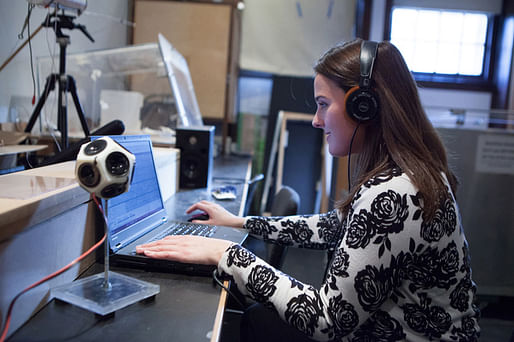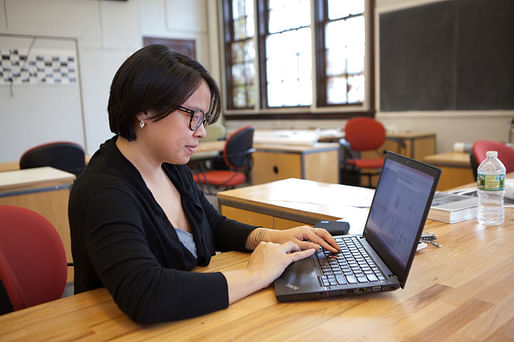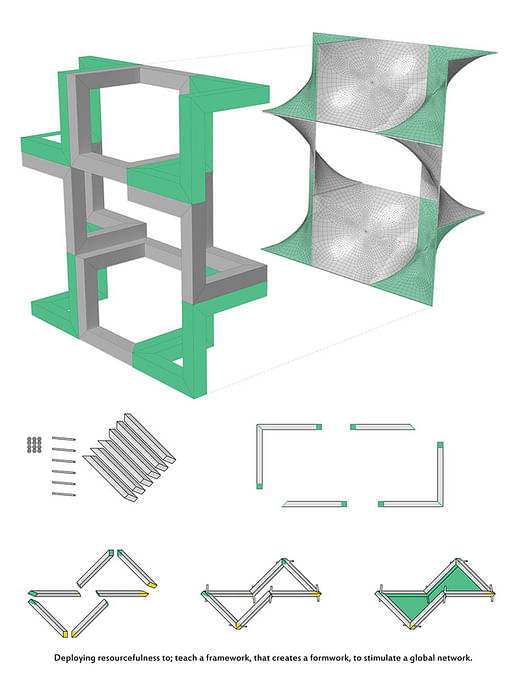

The practice of architecture in the twenty-first century is increasingly driven by heightened cultural, social and environmental issues demanding that a greater degree of specialized knowledge be accessible in professional degrees. Rensselaer’s Master of Architecture program responds to this challenge with the integration of cutting edge research study into its coursework and studios, where students directly confront the most relevant contemporary ecological issues. The M.Arch program also offers minors in specialized areas, and enrollment into Master of Science research programs upon completion of the Master of Architecture degree.
The Master of Architecture engages innovative building science research with a full semester residency at the Center for Architecture Science and Ecology (CASE) located within Skidmore Owings and Merrill’s [SOM] New York City office. The residency offers M.Arch students firsthand experience in research implementation, execution and collaboration with a renowned firm. There are additional post professional programs that offer all current students unique opportunities and connections: the Architectural Acoustics Program, the Lighting Research Center (LRC), and the Geofutures M.S.Arch, all which allow RPI students the opportunity to deepen their interdisciplinary experiences.
Two current students, Mary Tieu LaFave (M.Arch ’17) and Rebecca Elder (M.Arch ’16) have expanded their passions for built ecologies, next generation sustainable technologies and environmental sciences, into minors and additional Master’s degrees in Architectural Sciences.
We sat down with Mary and Rebecca during their busy fall semester to ask about their career path and how their current educational experience at RPI’s School of Architecture is shaping their ideas about the profession.
RPI SoA: Who or what were your influences in selecting RPI for graduate school?
Rebecca Elder:
The CASE program initially drew me to the graduate program here at RPI. The program offers a chance to study in NYC collaborating with professional in the field alongside PhD students pursuing research in sustainability in the built environment.

↑ Rebecca Elder working in the architecture acoustics lab.
Mary LaFave:
I decided to apply for the RPI School of Architecture because I saw the school as an opportunity for me to tie together all my interests under one subject. Before I started at RPI I was working in a law firm and when I took a tour of the school and saw the studios, I just knew it was where I belonged.
At the time RPI and architecture felt impossible because I was searching for a medium to tie together my political, philosophical, and artistic interests. When I was accepted to the Rensselaer Polytechnic Institute, I still was not sure that architecture would be my medium. It did not take long to realize that architecture is the ultimate expression of all I am passionate for and all that I practice.

↑ Mary Tieu LaFave working with Grasshopper for Rhino on custom environmental analysis in the design studio.
RPI SoA: How are you expanding/drawing upon your previous degree?
Rebecca: My Masters of Architecture thesis at RPI gave me the chance to pursue research in human perception and its relation to the simulative and built environments. Expanding my scope of study, I took a course in aural acoustic to strengthen my knowledge of the human sense, thus increasing my interest in the topic of acoustics. The opportunity to branch out to the other realms of architecture pushed me to apply to the Architectural Acoustics Masters. My research has become multidimensional and is advantaged through the assembling of my varying backgrounds.

↑ Rebecca conducting acoustic field tests on site.
Mary: I have a BA in Political Science and a BA in African and African American Studies. My interests have always prioritized social, economic and political justice. Where liberal arts can teach you the legal routes through which justice can be achieved, I have always been extremely compelled by art and its role in the political realm. Architecture can be considered an artistic endeavor, but it is so much more. Since coming to RPI, I find that art is inspiration, but architecture is my medium. My projects at school reflect my ethos for pursuing and developing projects that illustrate architecture as an art form that brings forward social issues as design opportunities.
RPI SoA: What kind of project are you working on now?
Rebecca: My research focused simulative immersive environments and human scale representation. RPI works together with the Craive Lab, a 360-degree panoramic projection space equipped with 12 projectors and 128 speakers. With this technology, we are able to investigate our built environment and negotiate the relationship between designed space and perceived space.
When immersed in an environment that works to trigger varying senses one can be more aware of the space as well as their human presence. Installations and scaled forms of representation aid in researching our senses through altering reality and space. These spaces challenge the human perception by simulating environments without simply replicating them visually.

↑ The Senses and its relation to immersive environments.
Mary: The project I’m working on is a modular panel system that is a growing medium for edible greens. I am studying paper pulp as a material that is easy to break down and press into the panels and use as a medium for plant life to grow. I have a whole process where I break down the paper and soak it before embedding the paper with seeds and then press it into panels. The idea is to deploy the concept of how these panels are made and teach a local economy how to make these panels. The ultimate goal is to provide a product that creates supply and then a demand that can be a player in a local market. My project statement is, “Deploying resourcefulness to; teach a framework that creates a formwork, to stimulate a global network.”

↑ Assemblage and formwork for Mary’s panel study.
RPI SoA: What are your motivations and inspirations for this current project?
Mary: My main focus in this project is developing a process of making that can be deployed in many settings to many places. The point is to design a process that is easy to understand and replicate to create a market for these panels in areas that have agricultural scarcity. Ultimately, how the panels are used architecturally lies with the people who will receive instruction on how these panels are made, because these are the people who will interact with the design the most. In this project, I suggest how my panels can be assembled as a screen or a ceiling, but not leaving out that they can be used to grow a food source.

↑ Rendering on Mary’s proposed panel reproduction.
RPI SoA: What are your plans upon completing your graduate studies at RPI?
Rebecca: After graduating I hope to explore the field of experimental architecture. With my background at CASE and knowledge of acoustics, I have been looking into work that expands upon the ideas of phenomenology and the senses. The field of architecture is always changing and we are lucky to be a part of this generation of architects and designers. Us as designers are not limited to the one definition of an “architect”, with advancements in technology and collaborations with professional from fields ranging from biology to engineering are occupation is expanding every day.
Mary: After my semester at CASE, and seeing what kinds of solutions architectural design has to offer the world, I feel compelled to continue studying plant growth in alternative forms. On that front, I am considering a Fulbright study to continue this research. Alternatively, RPI offers a GeoFutures M.S.Arch program that I am considering because it is a great fit for my interests in agriculture in the built environment. I’m finding that I would like more exposure to the design process and engage different design developing processes.
For additional information on RPI’s Master of Architecture program and to apply see the graduate admissions website. The Master of Architecture program is a six semester (three year) program with summer internships and research assistantship opportunities. The application requires a full digital portfolio of previous creative works. RPI’s Master of Architecture program application does not require the Graduate Entry Examination (GRE). Merit-based scholarships are available to qualified applicants with priority given to applications received prior to January 1, 2017. The application deadline is January 1, 2017. Late applications will be reviewed on a rolling basis after this point in our late submission process.
The School of Architecture also offers a Digital Workshop for all incoming students which provides a comprehensive introduction to a wide range of software, including Rhino, Grasshopper, V-Ray, Pepakura Designer, and Adobe programs such as Illustrator, Photoshop, and InDesign.
For more information about the M.Arch program at Rensselaer, please visit the program website: http://march.arch.rpi.edu/, you may also contact us directly at gradarch@rpi.edu or 518-276-6877.
No Comments
Block this user
Are you sure you want to block this user and hide all related comments throughout the site?
Archinect
This is your first comment on Archinect. Your comment will be visible once approved.